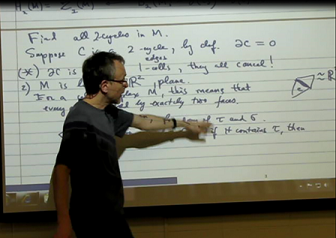Computer Vision & Math contains: mathematics courses, covers: image analysis and data analysis, provides: image analysis software. Created and run by Peter Saveliev.
Home of Math
From Computer Vision and Math
This is an online textbook of mathematics, with both early college courses and advanced courses for the majors, and applications related to computer vision, image and data analysis.
The main source of the courses presented here are the ones that I have taught recently at Marshall University. They, along with a few in the planning stage, are listed below.
Some stats:
- over 800 articles,
- over 2100 illustrations,
- 7 semester courses,
- 23 credit hours.
The long-term goal is to make the site completely self-contained. I would like this site to cover a big chunk of the math curriculum, interlinked with the image and data analysis topics.
The content comes directly from my lectures. I use SMART Tablet PC with Windows Journal (and HP Slate for editing). I started doing this in the fall of 2009 and I really love the results: bright, colorful slides like in PowerPoint but with the spontaneity and flexibility of the chalkboard. I transcribe the lectures into text, create articles on this site, and insert the illustrations as images. The end result is in TeX and it looks great!
I think this approach has huge advantages over the common practice of simply posting video lectures online: read-ability, search-ability, edit-ability, link-ability, the speed of download, etc. As a bonus, I can rearrange the content into any course I like (see below and also my fantasy math project). For other alternatives, see Math online.
The wiki format was chosen for its simplicity. There is no intent to make this site, which is an online textbook, match Wikipedia's goals of completeness, definitiveness, etc. On the other hand, "trivial" details, "elementary" examples, "easy" exercises, etc shouldn't be omitted. Indeed, the source of articles is always a complete set of lectures. In fact, not only the set is complete, each lecture is complete too -- everything that appears on the board is included in the course. The format is informal and most of the articles remain somewhat unpolished, just like the lectures they came from. The site (and the books) is a work in progress...
The multi-stage procedure:
- prepare for the lecture by creating the initial notes;
- deliver the lecture (with a tablet) which always ends up very different from the textbook or the notes;
- save the notes as a Journal file (and also in pdf, for the web);
- edit the Journal notes: rewrite in full sentences to make the text more readable, clean up illustrations, proofread;
- transcribe the notes into TeX, put the result online with illustrations inserted;
- edit this text: make it more narrative, improve formatting, add links, proofread again.
The whole procedure is more time consuming than I expected initially. Stage 5 is especially hard and has required outside help. Stage 7 should be further polishing and more proofreading. I hope one day to be able to add stage 8: make the illustrations more professional.
Ongoing:
- Linear algebra: course just finished,
- Statistics: course in the middle of stage 4,
- Group theory, Differential equations, and College algebra coming up.
Drop me a line if you have any questions or would like to contribute.
Best of luck!
A
C
D
G
H
I
L
M
N
P
R
S
T
V
One can reach this page by typing HomeOfMath.com.
Digital discoveries
- Casinos Not On Gamstop
- Non Gamstop Casinos
- Casino Not On Gamstop
- Casino Not On Gamstop
- Non Gamstop Casinos UK
- Casino Sites Not On Gamstop
- Siti Non Aams
- Casino Online Non Aams
- Non Gamstop Casinos UK
- UK Casino Not On Gamstop
- Non Gamstop Casino UK
- UK Casinos Not On Gamstop
- UK Casino Not On Gamstop
- Non Gamstop Casino UK
- Non Gamstop Casinos
- Non Gamstop Casino Sites UK
- Best Non Gamstop Casinos
- Casino Sites Not On Gamstop
- Casino En Ligne Fiable
- UK Online Casinos Not On Gamstop
- Online Betting Sites UK
- Meilleur Site Casino En Ligne
- Migliori Casino Non Aams
- Best Non Gamstop Casino
- Crypto Casinos
- Casino En Ligne Belgique Liste
- Meilleur Site Casino En Ligne Belgique
- Bookmaker Non Aams
- онлайн казино с хорошей отдачей
- スマホ カジノ 稼ぐ
- Trang Web Cá độ Bóng đá Của Việt Nam


